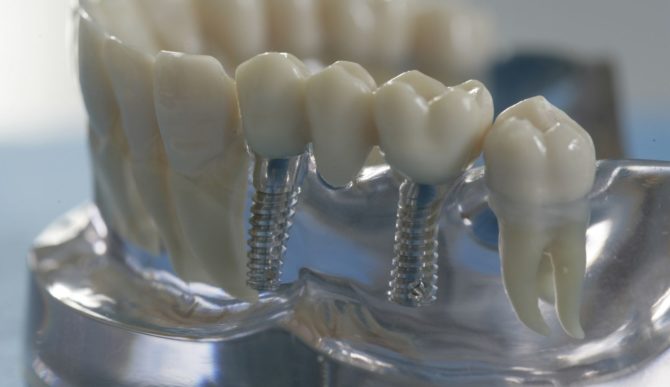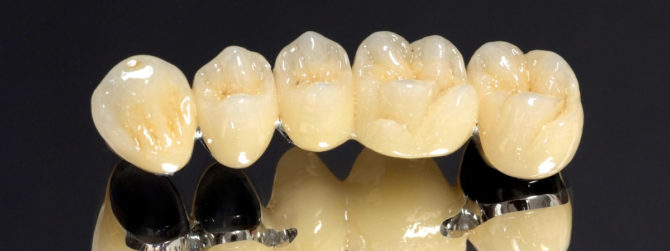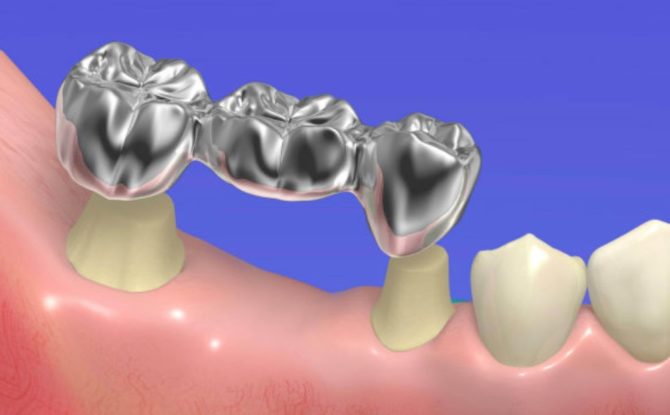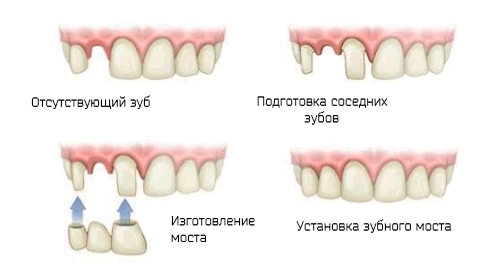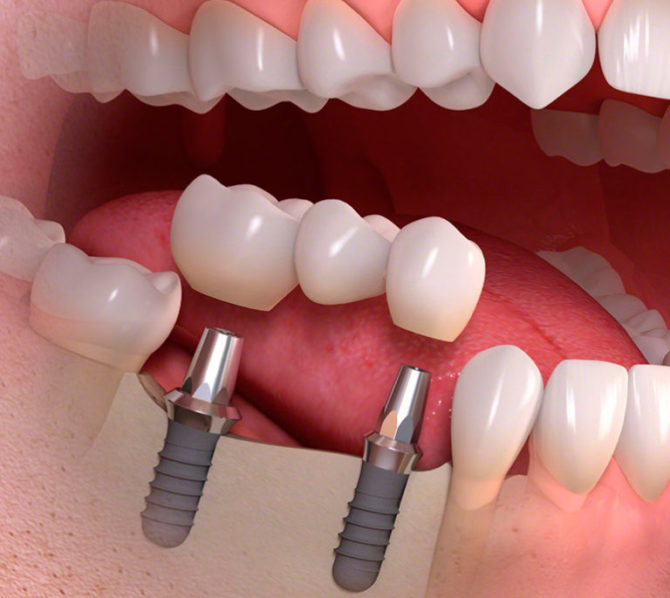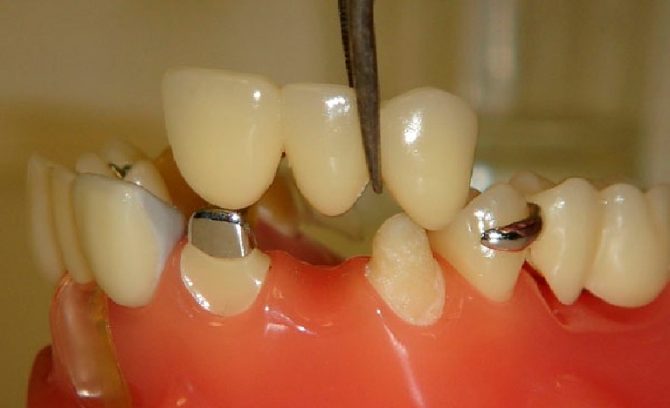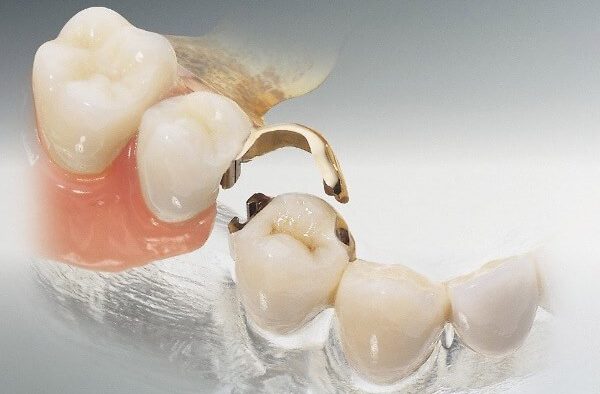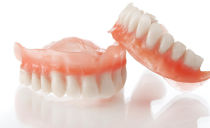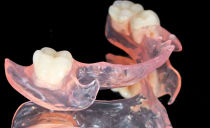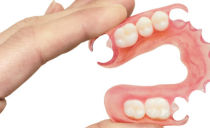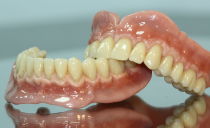Types of dental bridges, which are better, how to put and how much they cost
Gaps in the dentition cause several problems at once. Among them, incorrect digestive tract function, atrophy of bone tissue, deformation of the jaw. This is what doctors are trying to avoid when they propose to install a dental bridge made of cermet or metal. The patient himself is often worried about the aesthetic component.
Content
When a prosthesis is needed
Direct indication - loss of four anterior or three chewing teethlocated nearby. In this case, the installation of bridges on the teeth will solve both practical and aesthetic problems. In other situations, the doctor can offer implants, each of which is a complete analogue of a natural tooth and is installed separately.
What does the dental bridge and its design look like?
A dental bridge or bridge is a permanent, fixed orthodontic design. The purpose of placing it in the oral cavity is to replace deleted or lost positions. Extreme places are occupied by artificial crowns for healthy teeth or other supporting devices. The intermediate part is given under artificial teeth.
Dental bridge for 3 teeth in the photo:
To hold the prosthesis in the oral cavity, abutment teeth are required. The whole structure is mounted on them. According to the method of attachment, two types of dental bridges are distinguished:
- Classic, when healthy teeth that have become a support are completely closed with a crown.
- Adhesive. In this case, the design is installed on the halves or even quarters of the crowns, attaching to the natural base with special dental glue.
In favor of the second variety is the ability to maximize support teeth in their original form. However, only a doctor can decide which prosthesis is best placed for a particular patient.
Dental Bridge Materials
Patient comfort, aesthetic qualities, and bridge life are highly dependent on the material. The best characteristics are metal and cermets. These materials are most often used by dentists.
Plastic bridges are also known. But they can be used only for temporary wear, since they do not differ in either durability or convenience. The average service life of a plastic product, even in cases where the metal structure is the basis, is 4 years. During this time, the plastic changes color (darkens, turns yellow) and collapses under the influence of the alkaline environment of the oral cavity.
A temporary bridge for teeth made of plastic is the best choice for wearing if a permanent product is not yet ready, and spaces cause tangible inconvenience. Usually this happens in the smile zone.
Cermet tooth bridge
Fixed ceramic metal dental bridge is durable and beautiful. It is based on a reliable metal frame. The upper part is covered with ceramics. Such a bridge, also known as the Maryland bridge, lasts at least 7 years. All this time, he retains the natural shade of enamel and all the features of a given shape. But, despite the mass of positive aspects, the ceramic-metal bridge has contraindications for installation.
When a ceramic-metal prosthesis cannot be inserted
The list of contraindications reveals the absence of more than four adjacent teeth. Other methods should be used to solve this problem. It is also not recommended to install cermets when:
- masticatory parafunctions;
- acute stages of periodontitis;
- insufficient height of the supports.
Like any modern science, dentistry does not stand still. Yesterday it was impossible to put a prosthesis from cermet for many diseases. Today this list is significantly reduced. New methods of fastening, improved quality of materials, advanced technology have made the process more accessible.
Metal dental bridges
According to the manufacturing method, two types are distinguished: metal bridges on teeth can be cast and stamped. The starting materials are nickel, gold, cobalt and chromium. Solid casts are most preferred. They withstand extreme chewing load, have a long service life and are characterized by accuracy of shape. Indisputable advantages of metal prostheses:
- the convenience of the patient, ensured by technological performance, the exact repetition of the anatomical shape;
- the possibility of installation in difficult cases: when abrasion of hard tissues, deformation of the jaw.
And the main advantage is low cost. This is one of the most popular types of prosthetics. If precious metals are not included in the alloy, the price of one crown will not exceed the amount of three thousand rubles.
Cons of using metal alloys
The presence of such material in the mouth may give a metallic aftertaste, it will be better if the top layer of the bridge is ceramics. This is one of the drawbacks. The second minus is the lack of aesthetics of the “native” tooth. This drawback is especially important when a bridge is placed on the front teeth, and the external attractiveness of the structure comes to the fore.
Below you can see how the dental bridge looks in the photo, if only metal is selected for prosthetics:
And the third minus is the possibility of oxidation. Dentistry knows many cases when the gastric mucosa was damaged by old metal prostheses. In order to avoid such situations, it is important to consult a dentist in time, find out from a specialist which dental bridges are better, and replace an outdated design.
How to put a bridge on your teeth
Incorrectly selected type of prosthesis, inaccuracies in manufacturing, unprofessionally performed preparation - all these are the causes of complications that occur after the installation of bridges. Therefore, it is better to put prosthetics in specialized clinics. They have the following algorithm:
- A full examination of the oral cavity, including an x-ray and an assessment of the clinical situation.
- Remediation of the oral cavity.
- Removal of nerves, filling of channels and turning of supporting teeth.
- Making casts.
- Production and fitting of a prosthesis, identification and elimination of inaccuracies.
Only after this, the bridge structures are fixed with a medical cementitious mortar, and the patient receives an exhaustive consultation on the care of the prosthesis.
Additional services
Many dentists in Moscow offer a computer simulation service where a patient can evaluate the appearance of a future prosthesis, its size and shape on video. Since fixed bridges are installed for a long time, this service should not be neglected. The video will show the pros and cons, will allow to establish an effective dialogue between the doctor and the patient.
In especially difficult cases, the doctor may suggest making implants for support positions. Due to this, the intermediate part of the prosthesis is reduced, the problem of early loss is solved. The cost and duration of the restoration in this case will increase.
Bridges or implants: what to choose
Some patients do not like how the bridge looks on the teeth. Others are afraid to break the supports while turning. Doctors can add a few more points to this:
- uneven distribution of pressure on the chewing surface;
- violation of the integrity of tooth enamel;
- short term of operation.
Even if the Maryland metal-ceramic prosthesis is installed in the mouth, after 7-10 years it will become worthless. In this, fixed dental bridges lose to modern implants that have been “living” for 20 years or more. However, only a doctor can offer implants, and also decide whether bridges are needed on the teeth and from what material to make them.
Patient choice may be limited by external characteristics and cost. Before making a decision, it is worth knowing how much it costs to put a bridge on your teeth and how much the implant installation will result in.
Successful combination
There are situations when the best way out a combination of two techniques: installing a bridge and implant implantation. This approach is used with absolute adentia - the complete absence of teeth and their replacement in the oral cavity. Then the mounted artificial teeth are used as a support, and a prosthesis is installed between them. This is the best solution for those who do not want to use the classic false jaws.
How to take off
If a lot has been written about how dental bridges are placed, then articles about their removal are rare. But practice shows that the process has been worked out and is not difficult for the doctor. At the first stages, the technician achieves crumbling of adhesive materials located on two abutment teeth. To do this, use pneumatic or specialized ultrasound systems. Then the prosthesis is gently poked with forceps and removed from the oral cavity.
The patient does not experience discomfort, pain. Healthy teeth during removal do not loosen, do not fall out. Later, you can reinstall a new prosthesis on them.
The photograph shows a removed bridge on the front teeth:
Practice shows that the prosthesis can serve more than it is allotted to the guarantee. And in good condition and carefully performed removal, it can be inserted back after solving the problems that have arisen: treating caries, stopping the inflammatory process, eliminating pollution. The bridge on the front teeth is often reinstalled, as caring for it is simple and affordable.
Possible problems and complications
By inventing a bridge, dentistry solved the problems of many patients. However, this technology has its drawbacks. These include complications such as:
- inflammation of the mucosa at the site of contact with the denture;
- periodontal atrophy;
- loose and loose teeth;
- pulpitis;
- pathological abrasion of healthy antagonist teeth;
- malocclusion;
- allergy.
The occurrence of complications depends on how the bridges are made to the teeth, whether the technology is followed, or whether the material is tolerated. It is worth contacting a doctor for any tangible discomfort. Even if the prosthesis staggers, but there is no pain.
What to do if the dental bridge staggers
There are three reasons why the Maryland prosthesis can stagger:
- One of the supporting teeth broke or fell out.
- Two abutment teeth broke.
- The structure on which the fastening elements are held has collapsed.
To understand the reason, the doctor must know how much the dental bridge in the oral cavity costs (if the life is nearing the end), what sensations the patient experiences. A careful examination and x-ray examination of the roots of the abutment teeth are inevitable. Only after this, the doctor will determine why the dental bridge staggers and what to do.
It is worth noting that temporary strengthening measures will not help here. Only one way out - removal of the prosthesis. The second is not given. Especially if the supporting tooth is broken or dropped out.
Conditionally removable prosthetics
There is another way to fix dentures, which dentists call conditionally removable. This is not a temporary option - such a bridge has been installed for a long time. In fact, this is the same prosthesis, but with only one intermediate part. And instead of crowns, there are lock-type fasteners.
Conditionally removable bridge in the photo:
Such a prosthesis can be placed on natural and artificial teeth. It allows you to keep the enamel intact and can be easily removed, even if the abutment has not yet fallen out.
Trust the doctor
It’s not difficult to figure out how bridges are placed on your teeth and what are the options. Photos and videos on the Internet, scientific publications and television shows demonstrating how to put a bridge on your teeth make this task as simple as possible. But correctly assess the clinical situation, choose the right type of prosthesis and maintain healthy teeth can only be a doctor. Therefore, it is better to entrust your health and appearance to professionals.

